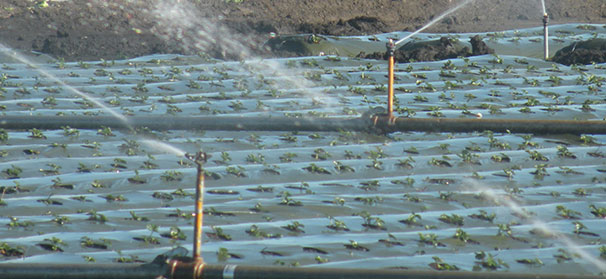

Feb 13, 2014California growers brace for dry year
Fruit and vegetable growers in the nation’s most productive agricultural state hope to get a little relief now that California Gov. Jerry Brown has officially declared a drought state of emergency following three seasons of low rainfall.
“We can’t make it rain, but we can be much better prepared for the consequences that California’s drought now threatens, including dramatically less water for our farms,” Brown said.
The declaration, issued Jan. 17, gives state water officials more flexibility to manage California’s water supply. Brown also directed state officials to assist farmers and communities that are economically impacted by the extended drought.
California’s rainfall totals have been below normal for the past three years, and 2014 is projected to be the driest year in the state’s history, according to the state government.
The lack of rainfall has growers extremely concerned.
“It’s topic A for everyone,” said Dave Kranz, a spokesman for California Farm Bureau Federation, which represents nearly 78,000 farmers and ranchers. “It’s a statewide phenomenon. We know it will be a tough year, but we don’t know how tough it will be. We know there will be a pretty significant deficit, but we won’t know how significant until mid- to late March.”
California’s rainy season normally extends through the end of March. Growers were hopeful that the massive high-pressure system that was blocking storms from reaching California in winter would break down before spring. Even if the rains materialize, however, it will take a long time to recover from three years of below-normal rainfall, according to media reports.
The drought is hitting California’s $44.7 billion agriculture industry the hardest. Roughly 80 percent of the state’s water supply is used by farmers and ranchers, who grow more than 250 crops and are the sole producers of a dozen commodities, according to state statistics.
According to state water officials, growers collectively irrigate about 9.6 million acres of farmland annually. The vast majority of that water comes from snowmelt or groundwater. Measurements taken in the Sierra Nevada Mountains in January showed the water content in the state’s snowpack was just 20 percent of normal for that time of year.
Even low-water crops might be affected by the drought. Cherie Watte Angulo, executive director of the California Asparagus Commission, said some growers in the Central Valley were considering pulling their crops. Although no decisions had been made at the time of Brown’s declaration, industry officials were very concerned.
“The drought will affect everybody in different ways,” Angulo said.
Strawberry growers in southern California had already noticed an impact. Strawberries are watered through drip irrigation, and the lack of rainfall was leading to dust problems.
“In the southern region, it’s very dusty,” said Carolyn O’Donnell, communications director for the California Strawberry Commission. “The dust can cause more pest problems, which the growers may see later in the season.”
Strawberry growers from the state’s northern region were forced to irrigate their fields in winter, raising production costs, O’Donnell said.
Some farmers, like the state’s apple growers, were taking a wait-and-see approach in January.
“It’s still a little too early to tell what the impact will be,” said Alexander Ott, executive director of the California Apple Commission. “March is when we’ll have an idea of where we stand.”
Raising additional concerns, the Golden State experienced unseasonably warm weather in winter. Ott was worried that the weather might lead to early blooms. That could be a problem if rain does come, or if a winter freeze occurs.
Tough choices
Brown’s emergency declaration heartened officials at Western Growers, which represents about 2,400 family farmers in California and Arizona.
“We appreciate the action taken by Governor Brown,” said Tom Nassif, president and CEO of Western Growers. “Drought conditions are wreaking havoc on farmers in California, especially in the San Joaquin Valley. The situation is dire and requires the full attention of state and federal leaders, which is why the declaration is so important.”
The official declaration will give the state water resources control board more flexibility in managing water supplies and will expedite water transfers throughout the state. However, no decisions regarding water transfers had been made as of mid-January, which was causing some uncertainty.
“All growers in California are worried, especially those in the Central Valley,” said Wendy Fink-Weber, senior communications director at Western Growers. “Some are already making decisions now to fallow the land.”
Some farmers were opting not to plant row crops so they could use their dwindling water supplies to keep their grapevines, fruit and nut trees – which take five to seven years to begin producing – alive. Farmers adopted a similar strategy when water supplies were short in 2009 – when an estimated half a million acres of farmland were fallowed throughout the state, Fink-Weber said.
“It’s fair to say a lot of land will be left fallow (this year), but it’s hard to say how much,” Farm Bureau’s Kranz said.
– Terri Morgan














